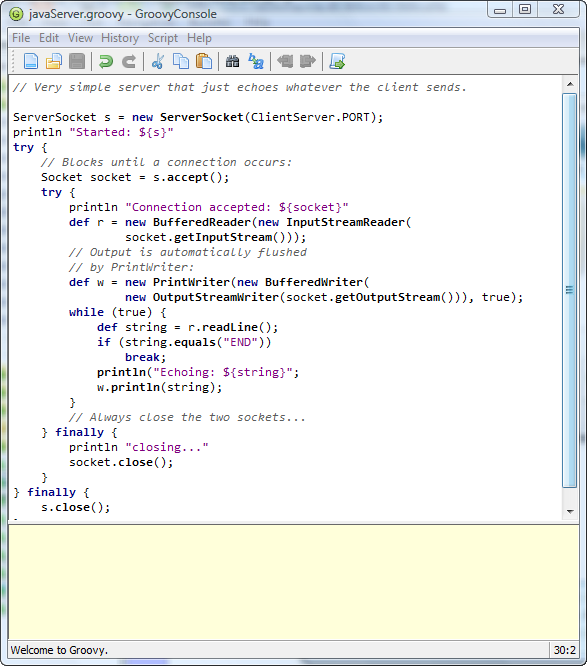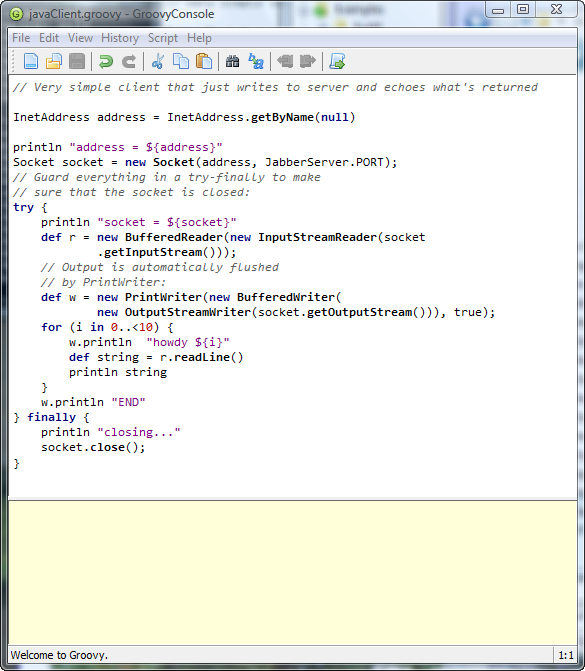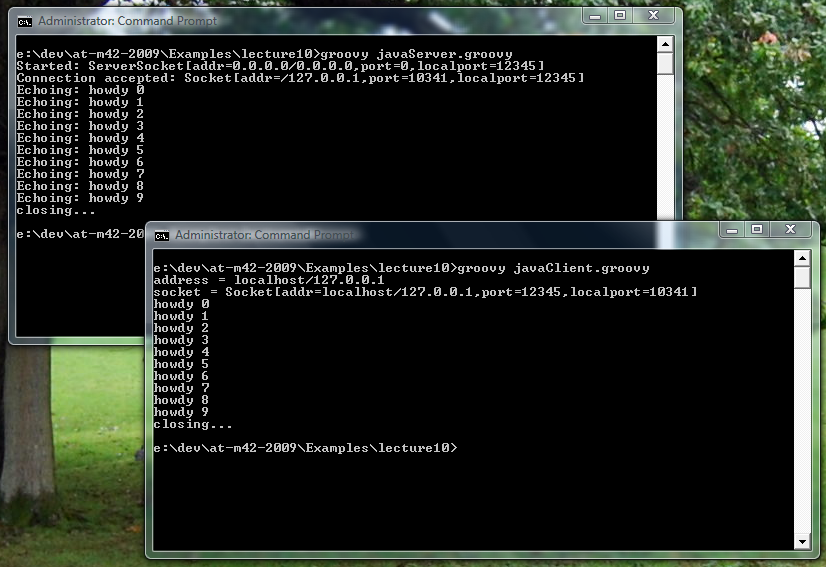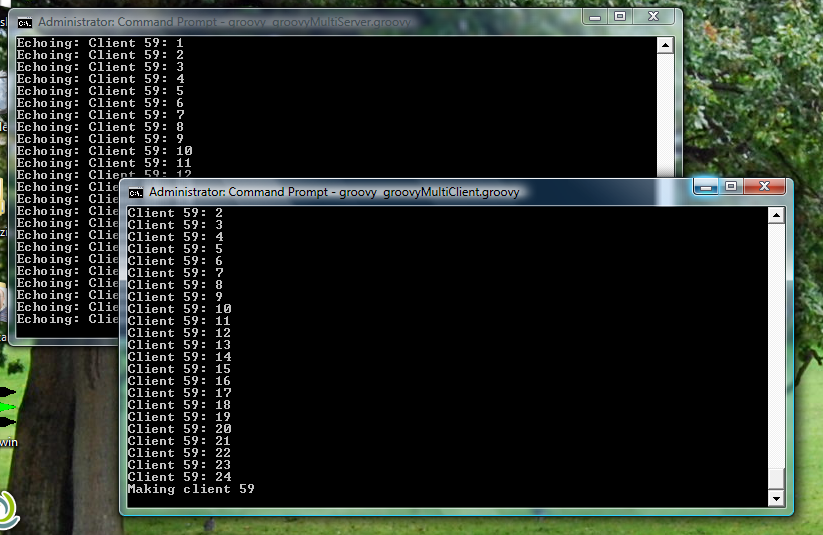Table of Contents
~~SLIDESHOW~~
Network Programming
- Historically error- prone, difficult, complex
- I/O stream library works quite well for TCP/IP
- Threading is also very useful and relatively easy here
- Networking support on the Java Platform fits well with (and supports) standard protocols: HTTP, FTP, TELNET, SMTP etc.
Identifying a Machine
- Uniquely identify a machine from all the others in the world
- IP (Internet Protocol) address that can exist in two forms:
- DNS (Domain Name Service) form:
www.swan.ac.uk - “Dotted quad” form:
137.44.1.7
- Represented internally by 32 bit number (4.3 billion possibilities).
static InetAddress.getByName()
- Produces
InetAddressobject containing address.
Who Am I?
Finds out your network address when you're connected to the Internet.
- 1 | Example 1: Examine the java.net.InetAddress object (at-m42/Examples/lecture10/whoAmI.groovy)
extern> http://www.cpjobling.org.uk/~eechris/at-m42/Examples/lecture10/whoAmI.groovy
<cli prompt='$'> $ java WhoAmI Usage: WhoAmI MachineName $ java WhoAmI www.swan.ac.uk www.swan.ac.uk/137.44.1.7 </cli> May be useful if your ISP dynamically allocates IP addresses for your dial-up connection.
Clients and Servers
- Two machines must connect
- Server waits around for connection
- Client initiates connection
- Once the connection is made, server & client look identical
- Both ends are turned into
InputStreamandOutputStreamobjects, which can then be converted toReaderandWriterobjects.
Testing without a Network
localhost: the “local loopback” IP address for testing without a network
InetAddress addr = InetAddress.getByName(null)
- Equivalently:
InetAddress.getByName("localhost")
- Or using the reserved IP number for the loopback:
InetAddress.getByName("127.0.0.1")
Port
- Unique “place” in a Machine
- IP address isn’t enough to identify a unique server
- Many servers can exist on one machine
- Process address includes a port number
- When you set up client and server, you must specify IP address and port, so they can find each other
- Not a physical location, but a software abstraction to represent a service
- Ports 1-1023 are reserved, others may be used (up to 64K)1)
Sockets
- Software abstraction used to represent the “terminals” of a connection between two machines.
- Socket is the actual 2-way connector. Can initiate a connection with a server.
ServerSocketisn't really a socket but more of a “Server Connector” that produces aSocketas the return value ofaccept( ), which waits for a connection.- In the end, you get a
Socketon each machine.
Just Like Files
- in Java, once you have a
Socket, you callgetInputStream()andgetOutputStream()to produce the correspondingInputStreamandOutputStreamobjects - You convert these to readers and writers, wrap them in a
BufferedReaderorBufferedWriterandPrintWriter - From then on, it’s like reading and writing any other I/O stream!
- groovy simplifies this further by the judicious use of closures.
Simple Client and Server
- Example 2 very simple server that just echoes whatever the client sends (code in the notes) which is closely based on Java equivalent.
- 1| Example 2: very simple server that just echoes whatever the client sends (at-m42/Examples/lecture10/javaServer.groovy)
extern> http://www.cpjobling.org.uk/~eechris/at-m42/Examples/lecture10/javaServer.groovy
Explanation: references to listing …
- Line 7 – create server socket at
ClientServer.PORTand wait for a connection - Lines 10 and 14 – attach I/O to connection and act as a server
- Lines 16-22 – act as an echo server
- Lines 24 and 28 – finally: always close the two sockets
The Client
- Example 3 Very simple client that just writes to server and echoes what's returned (code in the notes) which is closely based on Java equivalent.
- 1| Example 3: Very simple client that just writes to server and echoes what's returned (at-m42/Examples/lecture10/javaClient.groovy)
extern> http://www.cpjobling.org.uk/~eechris/at-m42/Examples/lecture10/javaClient.groovy
Explanation: references to code …
- Line 3 – open loop-back address
- Line 6 – create socket and connect to
ClientServer.PORT - Lines 11 and 15 – attach I/O to connection and act as a client
- Lines 17–21 – write to server and echo reply
- Line 23 – finally: close client socket
The First Run
This slide shows a run of these programs.
Server started first: <cli prompt='>'> $ groovy javaServer.groovy </cli> client started in a second command shell window. <cli prompt='>'> $ groovy javaClient.groovy </cli>
Groovy-Socket
- In Groovy
ServerSocket.acceptcan take a closure. - Also adds a method
withStreamsthat takes a closure to thejava.net.Socketclass. - Streams and sockets are closed after these closures return (even if an IO error occurs) so we don't need any
try-catchblocks.
Groovy-server
- 1|Example 3: A simpler Groovy server (at-m42/Examples/lecture10/groovyServer.groovy)
extern> http://www.cpjobling.org.uk/~eechris/at-m42/Examples/lecture10/groovyServer.groovy
Here we see how the use of closures simplify the logic of the server application, and also makes it much more readable. The necessary try-catch-finally code that Java needs can be hidden inside the definition of the server.accept(Closure) and socket.withStreams(Closure) methods. Similar usability improvements are to be found throughout the Groovy-I/O system. Most commonly used cases are supported, but if you need tighter control, you can always go back to the full Java patterns.
Groovy-client
- 1|Example 4: A simpler Groovy client (at-m42/Examples/lecture10/groovyClient.groovy)
extern> http://www.cpjobling.org.uk/~eechris/at-m42/Examples/lecture10/groovyClient.groovy
Similarly, the client is made much more understandable by use of the socket.withStreams method. You will also have noted the similarity of the actual code of the client/server logic.
Serving Multiple Clients via Threads
Since the Groovy closure implements the Runnable interface, to create a server that can handle multiple threads, we simply wrap the server.accept closure in a while(true) loop.
- 1|Example 5: A multi-threaded server (at-m42/Examples/lecture10/groovyMultiServer.groovy)
extern> http://www.cpjobling.org.uk/~eechris/at-m42/Examples/lecture10/groovyMultiServer.groovy
When a new client request comes into the server, the accept closure is activated in a new thread and the server can immediately go back to waiting.
Creating Multiple Clients via Threads
- 6: Client that tests the multiClientServer by starting up multiple clients (at-m42/Examples/lecture10/groovyMultiClient.groovy)
// ... def address = InetAddress.getByName("127.0.0.1") while (true) { if (threadCount < MAX_THREADS) { Thread.start() { // ... def socket = new Socket(address, ClientServer.PORT) socket.withStreams { input, output -> // client-server code } // ... } } Thread.currentThread().sleep(100) }
Full listing in the notes.
- 1|Example 6: Client that tests the multiClientServer by starting up multiple clients (at-m42/Examples/lecture10/groovyMultiClient.groovy)
extern> http://www.cpjobling.org.uk/~eechris/at-m42/Examples/lecture10/groovyMultiClient.groovy
As before, we use the power of closures this time to continually create client threads, connect to the server, and echo some numbers before sending the end message and shutting down.
The Second Run
This slide shows a run of these programs.
As before the server started first: <cli prompt='>'> $ groovy groovyMultiServer.groovy </cli> client started in a second command shell window. <cli prompt='>'> $ groovy groovyMultiClient.groovy </cli>
The client and server will continue to run until you kill the processes (with windows <key>C-c</key>).
User Datagram Protocol (UDP)
- Previous examples used Transmission Control Protocol (TCP).
- Very high reliability, message will always get there.
- Also high overhead.
- User Datagram Protocol (UDP) is an “unreliable” protocol which is much faster, but the messages won’t always get there.
Datagrams
- You make your own packets and write the address on the outside, send it.
- Based on packet contents, recipient decides whether they got everything, sends a message if they didn’t, you retransmit.
- Reliability must be enforced by your program, not by the UDP protocol.
Communicating with Datagrams
DatagramSocketon both server and client.- Sends and receives
DatagramPackets. - No “connection”: datagram just shows up.
- Only server must have fixed IP & port number
DatagramPacketcontains message of any length up to 64K bytes, IP address and socket # of destination.DatagramPacketobjects are used for holders of both sent and received datagrams
For Sending and Receiving
- For receiving, needs a buffer:
DatagramPacket(buf, length)
- For sending, needs buffer, IP address and port number:
DatagramPacket(buf, length, inetAddress, port)
- Here,
bufalready contains data to be sent,lengthis amount of buffer you want in datagram. - In the example, the server just echoes datagrams, client threads send datagrams & wait for echo.
Examples (online for Self Study)
- Dgram.groovy –- defines a UPD datagram
- chatterServer.groovy –- a version of groovyMultiServer using
Dgramobjects. - chatterClient.groovy –- a version of groovyMultiClient using
Dgramobjects.
Even Simpler Groovy Servers
- The
-loption lets you run aGroovyscript in client-server mode. - You execute a script (using
-eor by specifying a file) and groovy starts a TCP server on port 1960((Or another port if you wish to override it). - You can then connect to that port using a suitable client (e.g. Telnet)
whoAmI again
<cli prompt=“>”> e:\dev\at-m42-2009\Examples\lecture10> groovy -l 5000 -e “println 'ip address: ' + InetAddress.getByName(line).hostAddress” </cli> Now in another command window: <cli prompt=“>”> e:\dev\at-m42-2009\Examples\lecture10> telnet localhost 5000 localhost ip address: 127.0.0.1 java.sun.com ip address: 72.5.124.55 www.swan.ac.uk ip address: 137.44.1.7 </cli>
Ridiculously simple echo server
When a script is started in listening mode, standard-output is attached to the socket's output stream and the messages from the socket's input stream are available line-by-line to the programmer in variable line. Thus our echo server can be reimplemented as:
- 7: a really simple echo server (at-m42/Examples/lecture10/simpleServer.groovy)
extern> http://www.cpjobling.org.uk/~eechris/at-m42/Examples/lecture10/simpleServer.groovy
Run this as <cli prompt='>'> e:\dev\at-m42-2009\Examples\lecture10> groovy -l 12345 simpleServer.groovy </cli> Then run any of the TCP clients developed earlier.
A 75 Line Web Server
To demonstrate the power of Groovy, Jeremy Rayner, one of the core Groovy developers, wrote a simple HTTP server in less than 75 lines of code!
Listing is in the notes.
It really works: <cli prompt='>'> e:\dev\at-m42-2009\Examples\lecture10>groovy -l 80 SimpleWebServer.groovy </cli>
- 1|Example 8: a web server in 74 lines of code
extern> http://svn.codehaus.org/groovy/trunk/groovy/groovy-core/src/examples/commandLineTools/SimpleWebServer.groovy
Firewall Warning
You may find that the examples scripts will not run in the PC lab because either Groovy or Java be prevented from openning a port by Windows Firewall. You won't have the necessary privileges to allow. Should work on your own machine.



